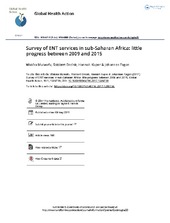| dc.description.abstract | Background: A 2009 survey of ENT, audiology, and speech therapy services and training opportunities in 18 Sub-Saharan African countries reported that the availability of services was extremely poor, the distribution of services was very inequitable, and training opportunities were limited. Objective: We conducted a new survey to determine the current status of ear, nose, and throat (ENT), audiology, and speech therapy services in sub-Saharan Africa. Method: This study is a cross-sectional study. A questionnaire was distributed by email to an ad hoc group of ENT surgeons and audiologists in 30 sub-Saharan African countries. Data from the current survey were compared to those of a 2009 survey. The numbers of ENT surgeons, audiologists, and speech therapists/100,000 people were compared to the ratios in the United Kingdom. Results: A total of 22 countries responded to the questionnaire. When data of the 15 countries that responded in both 2009 and 2015 are compared, the number of ENT surgeons had increased by 43%, audiologists had increased by 2.5%, and speech therapists by 30%. When the 23% population growth is taken into account, the numbers of ENT surgeons, audiologists, and speech therapists per 100,000 people had declined in four countries, and there remains a severe shortfall of ENT surgeons, audiologists, and speech therapists when compared to the UK Respondents cited lack of availability of basic equipment as the most frequent limitation in providing ENT services. Other important factors causing limitations in daily practice were: lack of ENT training facilities and audiological rehabilitation, low awareness of the burden of ENT pathology, as well as poor human resources management. Conclusions: There has been a lack of progress in ENT, audiology, and speech therapy services and training opportunities in sub-Saharan Africa between 2009 and 2015. There is a need to look at increased collaboration with developed countries and non-governmental organisations, establishing new and improving existing training centres in Africa, and task-shifting of some ENT services to primary health workers. | en_US |

